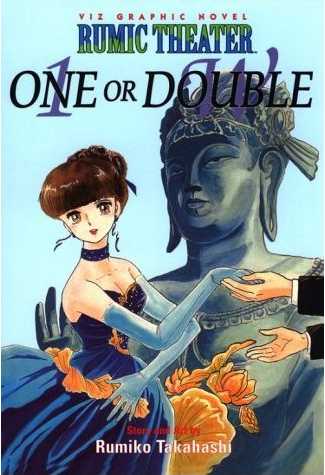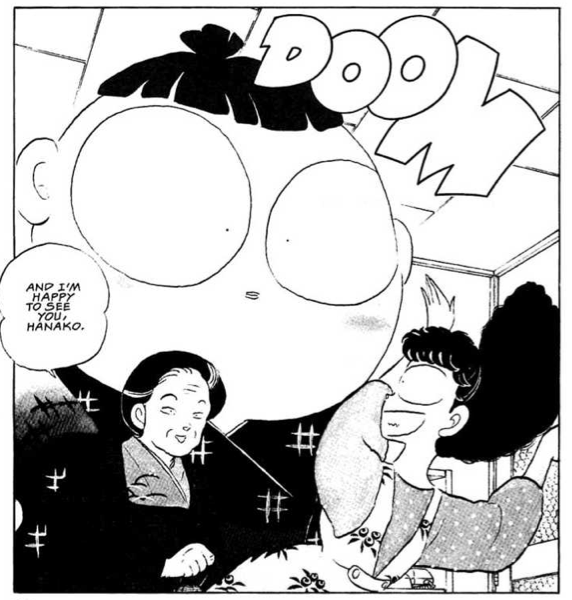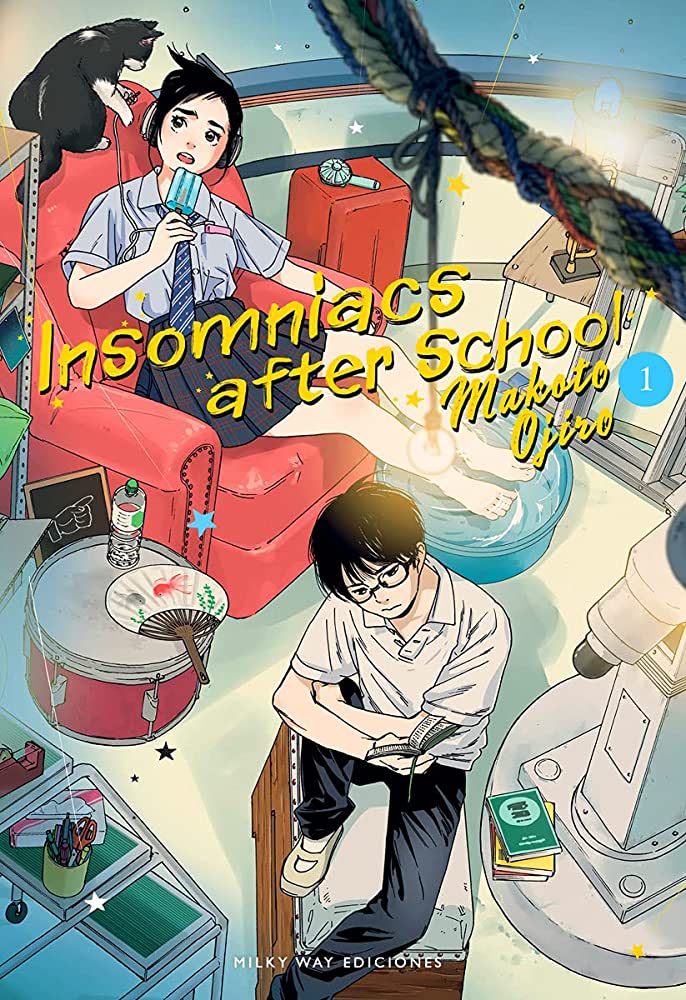Most American readers know Rumiko Takahashi through her work in Shonen Sunday, but Takahashi has a foot in the seinen world as well. Maison Ikkoku ran in Big Comic Spirits from 1980-87, alongside Area 88 and Wounded Man, while short stories such as “To Grandmother’s House We Go” and “One Hundred Years of Love” appeared in Big Comic Spirits‘ sister publication Big Comic Original. In Japan, Takahashi’s seinen shorts have been collected into four volumes: 1 or W, The Tragedy of P, The Executive’s Dog, and Red Bouquet. Here in the US, however, only two have been translated into English: The Tragedy of P, which was re-titled Rumic Theater (1996), and 1 or W, which was published as Rumic Theater: One or Double (1998). (N.B. One or Double includes a handful of shonen and josei stories that appeared in Shonen Sunday and Petit Flower, respectively.)
These two translated volumes showcase Takahashi’s ability to work in almost genre. There are sports comedies (“The Grandfather of All Baseball Games”), domestic dramas (“Hidden in the Pottery,” “House of Garbage,” “The Tragedy of P”), rom-coms (“The Merchant of Romance,” “The Diet Goddess”), pop-culture spoofs (“Shake Your Buddha”), and ghost stories (“To Grandmother’s House We Go,” “One or Double”). As with Takahashi’s work in Shonen Sunday, many of these stories fold supernatural elements into everyday situations. In “Extra-Large Size Happiness,” for example, a woman’s relationship with her mother-in-law is strained by the sudden and frequent appearance of a household spirit that only she can see, while in “Reserved Seat,” a ghostly grandma takes possession of her grandson’s body so that she can honor her season tickets at the Takarazuka Revue.
Takahashi is a master at establishing her premise in just a few pages, allowing plenty of room for character development and broad comedy without compromising narrative momentum. One of the reasons Takahashi can be so economical is that she invests even the smallest moments with telling detail, making sure that every aspect of a character’s behavior is consistent with the story’s premise. In “Excuse Me for Being a Dog,” for example, the hero — who turns into a shiba inu whenever he suffers a nosebleed — acts like a canine even in his human form: he investigates an abandoned book bag with his nose, curls his lip at strangers, and recoils in the presence of pungent odors. Takahashi doesn’t make a big deal of these behavioral tics, but their inclusion in the story elevates Shiro’s condition from a wacky plot contrivance to a fundamental aspect of his existence. (OK, it’s also a wacky plot contrivance.)
Takahashi’s deep affection for her characters also contributes to the stories’ success. Though they bicker and tease and goad one another, the characters’ good will and mutual affection is seldom in question, even when their judgment is. Takahashi is as generous with her least sympathetic characters as she is with her leads, allowing them moments of wisdom and decency that often challenge the other characters’ perception of them. In “The Story of P,” for example, a man agrees to care for his eccentric client’s pet penguin, despite the fact the Hagas’ apartment complex doesn’t allow pets. For most of the story, Mrs. Haga plays cat-and-mouse with her neighbor Mrs. Kakei, the head of tenants’ association and a reputed animal hater. (Mrs. Kakei keeps tabs on the other tenants, notifying the management of any pet violations.) Yet in the last pages of the story, we learn that Mrs. Kakei has complicated, emotional reasons for ratting out her neighbors that stem, in part, from a genuine concern for animal welfare and not a humorless love of rules.
Art-wise, Takahashi produces some of the cleanest, most accessible layouts in manga. Her characters’ faces are easy to read, and her scenes are staged for maximum clarity and emotional impact; no one times a scare or a punch line better than Takahashi. Even more striking is the sense of mischief and play that informs her artwork. The elderly heroine of “One Hundred Years of Love,” for example, gains the ability to fly after surviving a near-death experience. Takahashi draws the old woman astride an enormous crutch, soaring over an urban landscape. At first, Mrs. Hoshino mutters about the weather, but soon she embraces the possibilities of flight, buzzing an unsuspecting eight-year-old apartment dweller:
That same sense of mischief is evident in “Extra-Large Size Happiness,” in which a giant yokai pops into the frame — directly behind the frazzled heroine’s mother-in-law. Readers familiar with InuYasha‘s Shippo and Myogi will immediately recognize this round, genial figure:
The similarities between this nameless yokai and Myoga could be construed as a flaw or weakness of Takahashi’s style, but there’s an argument to be made that Takahashi employs a “star system” of her own. Granted, Takahashi never constructed a neat theoretical framework to explain the recurrence of certain characters in her stories, as Osamu Tezuka famously did for his. Flipping through the pages of Rumic Theater, however, it’s easy to imagine these characters as actors who specialize in certain types of roles, retaining something of their own “off-screen” personality and appearance in every story; as David Welsh observed in his recent essay on Ranma 1/2, “The fun is in seeing the specialists find variations on their distinctive themes.” And here, in Rumic Theater, the fun comes from seeing Takahashi’s regulars tackle more grown-up themes — marital discord, neighborhood politics, growing old — than might otherwise be permissible in the context of a long-form adventure such as InuYasha or Ranma 1/2 .









Ian S says:
Takahashi’s short stories are probably my favourite stuff by her – as much as I like some of her longer works, they do all tend to get pretty repetitive after a while. Her short stories have everything I love about her work with none of the pain.
By the way, Viz actually released five volumes of her seinen short stories – the other three volumes came out under the title “Rumic World Trilogy” and are equally well worth picking up. The third volume of the trilogy even features an autobiographical piece (the only one she’s done as far as I’m aware).
Katherine Dacey says:
Hi, Ian! Glad to see that other folks are as fond of these older anthologies as I am; it gives me hope that VIZ might eventually reprint them or — heaven forbid! — translate the later volumes of the Rumic Theater series.
Just a quick clarification about the material in the Rumic Trilogy series: many of the short stories in these volumes date to the beginning of Takahashi’s career, and were published in Shonen Sunday magazine. 1 or W is a transitional anthology, and contains work from Shonen Sunday and Big Comic Original. (And Big Comic Spirits, too, I think.) You can find publication information about each individual story at the Rumic World site: http://www.furinkan.com/rumictheater/manga/index.html.
BTW, thanks for being a voice of reason in the discussion vis-a-vis TOKYOPOP’s business practices; I didn’t anticipate that the conversation would become as heated as it did, so I appreciated the tone and thoughtfulness of your contributions.
Ian S says:
Thanks for the clarification about Rumic World Trilogy – I think my confusion stemmed from having made the cardinal mistake of trusting a Wikipedia entry…
Incidentally, I think both series were also serialised by Viz in Manga Vizion magazine if anybody is having trouble finding the books at affordable prices.
As for the Tokyopop discussion, thanks – I appreciate that. It was a really interesting debate and far more civilised than these things tend to be on the internet thanks to pretty much everybody involved.
lovelyduckie says:
I didn’t realize she had some anthologies, my first series from here was Inuyasha. But my favorite series from her is actually Mermaid Saga, I’ve seen the anime but haven’t read the manga yet. I’ll definitely be getting tehse anthologies if I can get a chance.
Katherine Dacey says:
The two Rumic series — Rumic Trilogy and Rumic Theater — are both out of print; VIZ published them in the mid-1990s, before manga had really taken off here in the US. I found my copies on eBay, though it took a while to find sets that weren’t ridiculously overpriced. (A few folks seem to think they’ll get $200 to $300 for a single volume in pristine condition.) Patience and persistent really helps. You might also look for floppy versions of the Rumic Trilogy stories. At least two — “Firetripper” and “The Laughing Target” — were published as traditional comic-book pamphlets.
As for Mermaid Saga, that’s one of my favorites, too! I was kind of disappointed in the anime — I thought the animation wasn’t very good. Then again, it’s been years since I watched it, so I don’t know if I’d stick by that opinion of it.
lovelyduckie says:
Remember how I said I’m the easiest person on the internet to sell manga to? LOL I found all the volumes from both series cheaply on Amazon from sellers 😉 already purchased all 5 volumes of Rumic Trilogy and Rumic Theater. I was able to pay a lot less than the original retail price, while I was at it I picked up her newer series Rin-NE too.
I’m excited to read the Mermaid Saga, I only recently bought it and I watched the anime so long ago it’s almost like I’ll get to experience it again for the first time. Although I’m currently reading Lady SnowBlood and will probably FINALLY finish up Spiral: The Bonds of Reasoning after. I also liked Maison Ikkoku, it wasn’t perfect but there were definitely some moments where I felt touched. I was actually particularly fond of Mitaka Shun.
Jade Harris says:
Ooo, this is one of those features you do such a great job on that I don’t have much to say, haha. Not that I ever have anything of much value to add, but here’s me grasping at random straws of thought when one of your articles really knocks it out of the park:
I actually don’t have any experience with these anthologies, they’ve always been a little tough to get ahold of. It’s cool to see how well she can wrangle different genres, but unsurprising considering she was making dojinshi from Kazou Koike’s manga school and worked as an assistant under Kazou Umezo. That’s why I have a lot impatience for people who write off Rin-ne as too little like Inu-Yasha, Inu-Yasha was, itself, more of an outlier to her career. With that in mind, I think some reprints would really compliment Rin-ne pretty well.
Jade Harris says:
Ugh, Kazuo, KazUO!
Jade Harris says:
And actually, here, I just found this trying to get a confirm on the Umezo bit and this is one of the best articles I’ve read on Takahashi:
http://www.csua.berkeley.edu/~leon/mi/html/rumiko.html
It’s pretty old, but a lot of good info there.
Katherine Dacey says:
Thanks for the link! I’d read that Takahashi had been one of Umezu’s assistants, and looking at her horror shorts, that makes total sense.
And I agree about Rin-ne; in many respects, I think it’s a return to what she was doing in Urusei Yatsura and Ranma 1/2, rather than a continuation of what she was doing in InuYasha. If anything, I think InuYasha has more in common with Mermaid Saga than any of her other works.